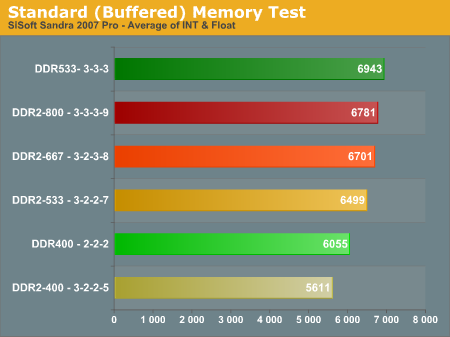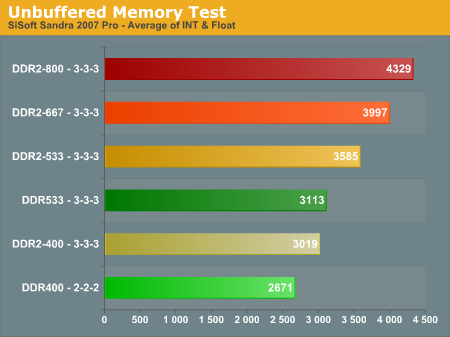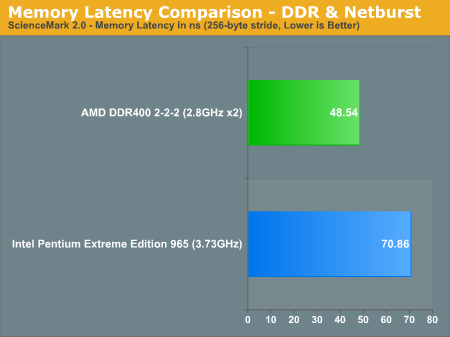DDR/NetBurst Memory Bandwidth and Latency
One of the most talked-about AMD advantages of the last couple of years has been their on-processor memory controller. This has allowed, according to popular theories, the Athlon64 to significantly outperform Intel NetBurst processors. The fact is NetBurst DDR2 bandwidth has recently been similar or wider in bandwidth than Athlon64 - even when the DDR is overclocked. You can see this clearly when we compare Buffered and Unbuffered Bandwidth of a NetBurst 3.46EE to an AMD 4800+ x2(2.4GHz, 2x1MB Cache) running DDR400 2-2-2 and running overclocked memory at DDR533 3-3-3.
The green bars represent DDR memory performance, while the beige to red are increasing DDR2 speed on NetBurst. Light green represents DDR400 2-2-2 while Dark Green is overclocked memory at the same CPU speed, DDR533 at 3-3-3.

In buffered performance, Fast DDR400 is only faster than DDR2-400 and slower than DDR2-533, 667 and 800. Overclocked memory at DDR533 3-3-3 is faster than any of the DDR2 bandwidths on NetBurst.
The Sandra Unbuffered Memory Test, which turns off features that tend to artificially boost performance, is generally a better measure of how memory will behave comparatively in gaming. The same green for DDR applies here.

Without Buffering, DDR400 has the smallest bandwidth of tested memory speeds and timings. Even overclocking to DDR533 allows the DDR to barely beat DDR2-400. DDR2-533, 667, and 800 all have greater Unbuffered bandwidth than the DDR overclocked to 533. NetBurst DDR2 memory bandwidth is generally wider than the bandwidth supplied by DDR memory on Athlon64. Despite the wider bandwidth, the deep pipelines and other inefficiencies in the NetBurst design did not allow the NetBurst processors to outperform Athlon64. Keep this in mind later, when we look at AM2 and Core 2 Duo Memory Bandwidth.
Latency
The other area where AMD has had an advantage over NetBurst DDR2 performance is memory latency, the result of the on-processor memory controller. Comparison of the AMD DDR Memory controller and the Intel DDR2 Memory controller in the Intel chipset shows AMD DDR with latency about 35% lower than Intel NetBurst in Science Mark 2.0.

While memory bandwidth was very similar between AMD and NetBurst, the deep pipes of the NetBurst design still behaved as if they were bandwidth starved. On the other hand the AMD architecture made use of the bandwidth available and the much lower latency to outperform NetBurst across the board.
One of the most talked-about AMD advantages of the last couple of years has been their on-processor memory controller. This has allowed, according to popular theories, the Athlon64 to significantly outperform Intel NetBurst processors. The fact is NetBurst DDR2 bandwidth has recently been similar or wider in bandwidth than Athlon64 - even when the DDR is overclocked. You can see this clearly when we compare Buffered and Unbuffered Bandwidth of a NetBurst 3.46EE to an AMD 4800+ x2(2.4GHz, 2x1MB Cache) running DDR400 2-2-2 and running overclocked memory at DDR533 3-3-3.
The green bars represent DDR memory performance, while the beige to red are increasing DDR2 speed on NetBurst. Light green represents DDR400 2-2-2 while Dark Green is overclocked memory at the same CPU speed, DDR533 at 3-3-3.

In buffered performance, Fast DDR400 is only faster than DDR2-400 and slower than DDR2-533, 667 and 800. Overclocked memory at DDR533 3-3-3 is faster than any of the DDR2 bandwidths on NetBurst.
The Sandra Unbuffered Memory Test, which turns off features that tend to artificially boost performance, is generally a better measure of how memory will behave comparatively in gaming. The same green for DDR applies here.

Without Buffering, DDR400 has the smallest bandwidth of tested memory speeds and timings. Even overclocking to DDR533 allows the DDR to barely beat DDR2-400. DDR2-533, 667, and 800 all have greater Unbuffered bandwidth than the DDR overclocked to 533. NetBurst DDR2 memory bandwidth is generally wider than the bandwidth supplied by DDR memory on Athlon64. Despite the wider bandwidth, the deep pipelines and other inefficiencies in the NetBurst design did not allow the NetBurst processors to outperform Athlon64. Keep this in mind later, when we look at AM2 and Core 2 Duo Memory Bandwidth.
Latency
The other area where AMD has had an advantage over NetBurst DDR2 performance is memory latency, the result of the on-processor memory controller. Comparison of the AMD DDR Memory controller and the Intel DDR2 Memory controller in the Intel chipset shows AMD DDR with latency about 35% lower than Intel NetBurst in Science Mark 2.0.

While memory bandwidth was very similar between AMD and NetBurst, the deep pipes of the NetBurst design still behaved as if they were bandwidth starved. On the other hand the AMD architecture made use of the bandwidth available and the much lower latency to outperform NetBurst across the board.










118 Comments
View All Comments
Calin - Tuesday, July 25, 2006 - link
I hate to rain on your parade, but the E6x00 and X6800 (Extreme) desktop CPU won't see a dual socket mainboard - for that you must use Xeons.As for multisocket, it was a niche market when multicore was not available, it is (maybe even more so) when multicore is available. Quad core will reduce it even more for desktop use. As for Intel knowing multicore is the future, I think their quad core will be on market before AMD's quad core - and if you are worrying about performance, keep worrying - we can small talk about this and that all day long.
AMD is in a much weaker position now - they must sell processors at half (or less) the profit they sold them until now, and the future is grim if you regard their profits. They could survive a long way, but they again are the budget CPUs, the best choice for small money.
As for 64-bit, you are certainly right - just that right now, 64-bit is of little use on desktop, the operating systems suffer from drivers problems, 64-bit applications are few and far between. You might need 64-bit and profit from it, but you are a minority now.
Ingas - Tuesday, July 25, 2006 - link
Maybe AMD in trouble.But not because of Core 2 Duo, but because of Woodcrest.
AMD alwais said that only server processors giving profit.
So ...
With Dell's AMD Now - maybe it's not trouble for AMD at all.
Calin - Wednesday, July 26, 2006 - link
Dell will only build enough AMD gear as not to lose business with their customers that WANT AMD gear. Even with higher performance losses on 4 sockets, Xeons Core2Duo (which are faster to boot) might put a fair fight against AMD - and then customers will choose based on other things than performance.I agree AMD Opteron scale better - but they start scaling from a lower performance
duploxxx - Wednesday, July 26, 2006 - link
do you really think you're sure about that. compare the same speed of opteron vs woodcrest and you will talk different.. i know how it performs because i have a wood es system on my table. and i am not a big fan of hexus reviews but look at the site, the wood isn't so bright and shining knowing again it is a compare of 3.0 vs 2.6.mesyn191 - Tuesday, July 25, 2006 - link
For 2S systems Intel will have the lead til' K8L becomes available, but for 4S AMD will have Intel beat and that lead will only increase when K8L becomes available. They're definitly gonna be hurting profit wise, but they'll be doing better than they were when it was P4C vs. AXP and they got through that so I see no reason to worry about them going into bankruptcy before K8L comes out in volume.sld - Tuesday, July 25, 2006 - link
What is wrong with a desktop user looking at the performance of a desktop cpu?When you can get a 4x4 at the same price/performance ratio curve as a Core 2 Duo, do please inform me.
I still believe AMD vs Intel is a David vs Goliath, although like the real David, AMD is beginning to get complacent with just a taste of power, and Core 2 is just what it needs to wake up and start dropping prices. :)
sld - Tuesday, July 25, 2006 - link
I forgot to mention that Core 2 is worth a consideration over the K8, but if we really want to punish Intel for being the monster they are, we should institute a complete boycott over the purchase of their existing Netburst inventory. That should hurt them quite a bit...Picture a scenario where new chips go straight out of the warehouse and into the embracing arm of a bulldozer. When it comes to that point do you think they will resort to giving the cpus away?
mattsaccount - Tuesday, July 25, 2006 - link
Are the Super Pi scores on page 7 right? The text says Conroe wins everything, but the Super Pi bench is reversed (I'm guessing the colors are just backward)Wesley Fink - Tuesday, July 25, 2006 - link
Since the lower score is better on Super Pi (faster time) the scales are reversed - from zero at the top to 90 at the bottom. The colors and values are correct, just upside down so the lowest score (fastest) is on the top like the other charts. You apparently caught that while I was typing this explanation :)highlandsun - Tuesday, July 25, 2006 - link
Have you got 32M digit results for Super Pi? Curious to see if that will exceed Conroe's cache and therefore reflect the real memory bandwidth. Also, results for running two copies of Super Pi at once on each system.